Taking advantage of the extra weekend day due to the holiday, we went out to see more in the area surrounding The Villages. This trip took us to Ocala National Forest, where we stopped at
Juniper Springs Recreation Area. Like Rainbow Springs, it was just beautiful!
This springs is in a subtropical setting and is one of the oldest and best known recreation areas on the East coast. There are hundreds of tiny bubbling springs here. This is the swimming complex and picnic area and you can see the Millhouse in some of these shots also.
The millhouse was a neat feature of this park. It was built by the CCC workers.
From their website:
Juniper Springs was an ideal place for a public recreation area, but
there was one problem. The site was located miles from the nearest
source of electricity and the cost of running lines out through the
national forest to the new park was prohibitive. The millions of gallons
of water that rush from the springs each day, however, soon sparked an
idea for a solution.
As work went forward on the recreation area in 1935-1936, the CCC came
up with a plan to generate electricity while enhancing the scenic beauty
of the springs.
They built the structure known today as the millhouse or old mill at the
foot of the main pool of Juniper Springs. Water flowing from the springs
was channeled into a narrow sluice and then allowed to pour back out to
its natural configuration.
The rushing water that poured through the sluice turned an undershot
waterwheel (so named because the water ran under instead of over the
wheel). That wheel, in turn, powered a generator in the millhouse that
produced more than enough electricity to meet the needs of the
recreation area.
The concept worked like a charm. Not only did the millhouse create
electricity, but the log and stone design of the structure added a
beautiful touch to the setting of the springs. It because a much loved
part of the site.
As interpretive panels at the old mill explain, the power plant was a
good example of a 1930s “green energy” project. It generated electricity
without destroying the scenic beauty of the springs and without
producing pollution of any kind.
The Juniper Springs Millhouse no longer generates electricity, but the
structure has been beautifully preserved. The stone wall at the
waterwheel end is a beautiful piece of CCC masonry work.
After visiting the millhouse, we took one of the hiking trails to another spring where we saw a gator. One of the rangers told me that someone asked him earlier if they feed the alligators. The other ranger joked, "Yeah, we feed 'em tourists!" It cracked me up.
We really enjoyed our visit at this beautiful place. Next time we need to bring our swimsuits and enjoy this:





















































